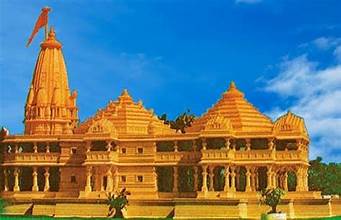Ram Temple Inauguration : The ancient city of Ayodhya, located in Uttar Pradesh, India, has long been steeped in spiritual and historical significance, particularly for the Hindu community. Recently, it has regained prominence due to the planned inauguration of the Ram Temple, a momentous event that has ignited both fervor and controversy. This article delves into the various facets of this significant occasion, exploring the cultural, religious, and social dimensions associated with it.
The Significance of Prana Pratishtha in Ram Temple
One of the central elements of the upcoming inauguration is the Prana Pratishtha ceremony. Jagadguru Rambhadracharya, a revered figure in Hinduism, explains that this ritual is not dependent on the temple’s architectural completion. He emphasizes that the essence of Prana Pratishtha, or the consecration of a deity, lies in the spiritual and ritualistic aspects, rather than the physical structure of the temple. This statement comes in response to those who argue that the temple must be fully constructed before the ceremony can take place. Rambhadracharya, with his deep knowledge of the scriptures, asserts that such views are misguided.
Prime Minister Narendra Modi’s Role in the Ceremony
The choice of Prime Minister Narendra Modi as the chief patron (Yajaman) of the Prana Pratishtha ceremony has also been a topic of discussion. Rambhadracharya addresses this by highlighting the criteria for being a Yajaman. He points out that Modi, known for his ascetic lifestyle and adherence to vegetarianism, fits the ideal of a spiritually disciplined individual, making him a suitable candidate for the role.
Shankaracharya’s Absence: A Non-Issue?
Another point of interest has been the absence of the Shankaracharya, another revered spiritual leader, from the event. Rambhadracharya downplays this, suggesting that the importance of the ceremony does not hinge on any individual’s presence. He states that his own participation as a Ramanandacharya holds equal religious weight, thereby ensuring the sanctity and significance of the event.
Understanding Prana Pratishtha: A Simple Explanation
For the uninitiated, Prana Pratishtha might be a complex concept. Rambhadracharya breaks it down, explaining that it involves infusing life (prana) into the deity through Vedic chants and rituals. This process, which will be performed on a statue of Ram Lalla (infant Lord Rama), encompasses several intricate rituals including the symbolic opening of the deity’s eyes and various offerings.
The Divine Offerings to Ram Lalla
Delving into the more intimate aspects of the ceremony, Rambhadracharya shares details about the offerings that will be made to Ram Lalla. He mentions that the deity will be offered ‘bhog’ (offerings of food), specifically yogurt and rice, with the rice being sourced from Chhattisgarh, believed to be Ram Lalla’s maternal home. This aspect of the ceremony connects the divine with the earthly, highlighting the blend of transcendence and tradition that characterizes Hindu rituals.
The Ram Temple: A Symbol of Cultural Renaissance
Beyond the religious and ritualistic elements, the inauguration of the Ram Temple in Ayodhya represents a significant cultural moment for India. It symbolizes a renaissance of Hindu culture and tradition, a reclaiming of historical and spiritual legacy. This event is not just about the construction of a temple, but about the revival of a civilizational ethos that has endured and evolved over millennia.
Disclaimer : इस न्यूज़ पोर्टल को बेहतर बनाने में सहायता करें और किसी खबर या अंश मे कोई गलती हो या सूचना / तथ्य में कोई कमी हो अथवा कोई कॉपीराइट आपत्ति हो तो वह jansandeshonline@gmail.com पर सूचित करें। साथ ही साथ पूरी जानकारी तथ्य के साथ दें। जिससे आलेख को सही किया जा सके या हटाया जा सके ।














